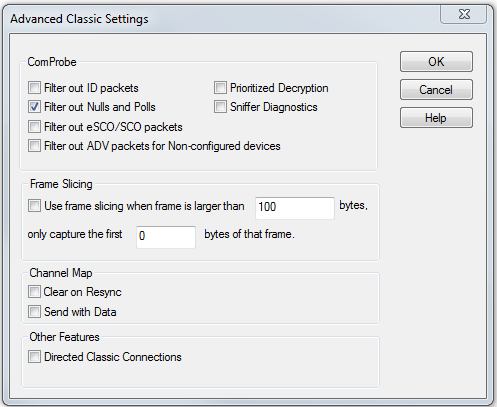BPA 600 Advanced Classic Settings
The Advanced Classic Settings dialog contains additional options for synchronizing the analyzer with the link to capture data.

BPA 600 Advanced Classic Settings
- ComProbe
Some packet types can be so numerous that they may make it more difficult to locate data packets in the Frame Display window. You have several options to exclude certain types of packets.
- Filter out ID packets - When this is checked, all ID packets are filtered out.
- Filter out Nulls and Polls - When this is checked, Nulls and Polls packets are filtered out.
- Filter out SCO/eSCO - When this is checked, SCO/eSCO packets are filtered out.
- Prioritized Decryption can be selected if you are having trouble establishing the correct decryption. This option adjusts the data capture to give priority to establishing the proper decryption over receiving frames. If you select this option, some frames may be dropped, but establishing the decryption key will be more efficient.
- Sniffer Diagnostics - When this is checked, some diagnostic data from the ComProbe are captured and stored in the .cfa file. This is useful when a .cfa file is sent to Frontline for analysis and diagnosis. Technical Support may ask you to check this option when you are experiencing issues with BPA 600.
-
Single Link Filtering - When this is checked, only packets from the specific Master and Slave selected in Devices Under Test are displayed. Data from other devices that may be connected to the Master will be filtered out.
- Frame Slicing Settings
- Frame Slicing Settings allows you to enter the size of the largest frame allowed to pass the analyzer without having any bytes removed. The second field tells the analyzer the number of bytes you would like to capture if the frame is larger than the allowable value indicated in the first field.
- Channel Map
- Clear on Resync -used to clear the map each time a re-synchronization occurs
- Send with Data - allows you to send a map each time data is sent instead of just sending a map when changes occur.
- Other Features
-
Directed Classic Connection - Applies to Classic Only Multiple Connections
The default configuration for Classic Only Multiple Connections is one master and two slaves. The Directed Classic Connection allows for simultaneous sniffing of up to three masters and three slaves in any combination. For example you can have one master with one slave along with a second master with two slaves, or three one-master one-slave connections.
- Click to place a check in the Directed Classic Connection check box.
- Click OK. The Advance Classic Settings dialog will close.
- In the Devices Under Test tab click on Classic Only Single Connection.
-
In the Classic Device drop-down lists select the address of the devices to be in your first link. Then right-click anywhere in the dialog. A link selector pop-up will appear. Click on Save to Link #1. The pop-up will close.
-
Repeat the link selection process for each additional link.
-
To review your saved links right-click and select View Directed Connecctions. All of your selections will appear in the Directed Connections pop-up window.
- Click on OK to close the pop-up.
- Selecting the Classic Only Multiple Connections will display the same information.
- To reset the Classic Only Multiple Connections to its default mode, select any other datasource configuration radio button and click on the Advanced button. Click on the Dircted Classic Connection check box to remove the check. Click on OK. The Classic Only Multiple Connections dialog will return to its default one master two slave configuration.
-
Classic Only Multiple Connections in Directed Classic Connections configuration